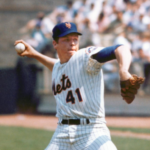I recently wrote an article about the reasons why Derek Lowe would not have been a wise investment, paired with why Oliver Perez was the best possible option if the Mets wanted to sign a free agent. It doesn’t mean Perez was a good signing, it means Lowe for 60 mil/4 years would have been a WORSE signing. Perez’s contract simply was the lesser of two evils. Unless somebody can give me a reasonable argument to have paid Jon Garland a high figure salary over 3 years prior to his 2009 season, then there is no other free agent option the Mets could have acquired.
Let’s ignore Perez for now. There seems to be a love affair going on between some Mets fans and Derek Lowe. The fact he is 36 years old, and having one of his worst seasons, while getting paid $15 million dollars and guaranteed that money until he’s 40 years old, for some reason is ignored by many. Allow me to finally put an end to this love affair.
When deciding a pitcher’s value, I personally like to first examine stats that they have control over. A pitcher either controls the at bat, or the hitter does. Thus, to me, Strikeouts and Walks are very important. There are a lot more stats out there that can really break down a player’s season or career. For example, somebody raised the point recently that Atlanta’s defense has been poor. Fair enough, but they have the same amount of errors as the Mets, so I’m not sure what putting him in a Mets uniform would have accomplished? The days of examining a pitcher based on W-L and ERA are quickly becoming ancient. Scott Feldman is 13-4, are we going to anoint him one of the best pitchers in baseball? Of course not.
In many ways, W-L can be a product of your team, while ERA can give you a false sense of just how good the pitcher really is. A great example would be Johan Santana versus Wandy Rodriguez. Who is having a better season? Santana in 25 starts is 13-9 with a 3.13 ERA, striking out 146, and walking 46 in 166.2 IP. Rodriguez in 25 starts is 12-7 with a much sexier 2.89 ERA, striking out 142, and walking 53 in 155.2 IP. Before stats like WHIP came into play, many would have said Rodriguez is having the better year. However, if you’re faced with those two options, I’d be shocked if anybody said Santana isn’t having the better season, even though his ERA doesn’t show it.
To be safe, I examined Lowe’s season with mostly traditional stats, such as Strikeouts, Hits, etc. Just to be on the safe side, I’ll explain the stats briefly that I used that in some case you may not be familiar with.
WHIP – Walks plus hits, divided by Innings Pitched.
GB/FB – Ratio of groundballs in play versus fly balls
BIPA – Balls in Play Average. This is a measure of Batting Average Against, not including Home Runs or Strikeouts.
DIPS ERA – A pitchers ERA, independent of the defense around him. Not a stat I generally pay attention to, but since somebody mentioned defense, I thought I’d share.
So, wrapping this all up, I ask a question. Right now, would you say Mike Pelfrey’s season is worth $15 million? Pelfrey is earning just under $3 million this year, and he’s 11 years younger than Lowe. Take a look at these numbers. They are having VERY similar seasons, yet one of them is 25 and improving, and the other is 36 and regressing and making almost $12 million more.
One thing to note, Lowe has started in 3 more games this season than Pelfrey. While some stats can remain a true measure even without equal starts, such as WHIP etc, I included a pace for stats like Hits, BB, K’s, just to give you an idea of where Pelfrey’s pace is when he hits 27 starts.
The first row is Lowe through yesterday’s start, the second is Pelfrey’s numbers as of today, and the third is Pelfrey’s pace up to 27 starts.
| GS | IP | H | ER | HR | BB | SO | WHIP |
| 27 | 158.2 | 182 | 79 | 8 | 50 | 82 | 1.46 |
| 24 | 140.2 | 156 | 73 | 9 | 50 | 82 | 1.46 |
| 27 | 157 | 176 | 82 | 10 | 56 | 92 | 1.47 |
| K/9 | K/BB | .AVG | .OBP | .SLG | GB/FB |
| 4.65 | 1.64 | .294 | .346 | .410 | 1.35 |
| 5.25 | 1.64 | .280 | .345 | .393 | 1.13 |
| 2B | 3B | HB | GDP | BAIP | DIPS ERA |
| 40 | 4 | 3 | 22 | .306 | 3.82 |
| 32 (36 pace) | 2 | 7 | 13 (15 pace) | .304 | 3.98 |
Pelfrey to me has had a below average year. I would like to think most fans would agree. Also, I am sure most are on board in thinking Pelfrey is NOT a #2 starter. One day, maybe. He’s only 25. Tom Seaver has said that a pitcher doesn’t truly learn how to pitch in the big leagues until he’s hit 100 starts. Pelfrey is at 73 right now for his career.
My point is this. Their numbers are very similar. The K/BB, WHIP, .OBP against, BAIP, even the DIPS ERA are proof that their seasons in terms of their own performance, independent of the team they pitch for, have been very familiar.
Yet, one of them is cashing a $15 million paycheck this season, and the other is continuing to try and grow within an organization at the young age of 25. So tell me this, would you say Pelfrey’s season earned him $15 million? I’d certainly say no to that. However, I would say that there is more of a realistic chance that when Lowe’s contract expires with the Braves after 3 more seasons, Pelfrey will have earned his paychecks, while Lowe will simply set the Braves back not only in their rotation, but in their team salary as well.
In conclusion, we had Derek Lowe pitch on our team this year. Except, he was 6-7, 230 pounds, and aged 25 making just under $3 million. The Mets didn’t need Derek Lowe this season, and they certainly do not need him at age 37, 38, or 39. Not signing Lowe, allows the Mets to pursue a true #2 type starter in John Lackey or Rich Harden. A move that not only would make the Mets a better team in the standings, but it will also make pitchers like Mike Pelfrey and John Maine better, because they won’t be asked to be something they aren’t.













